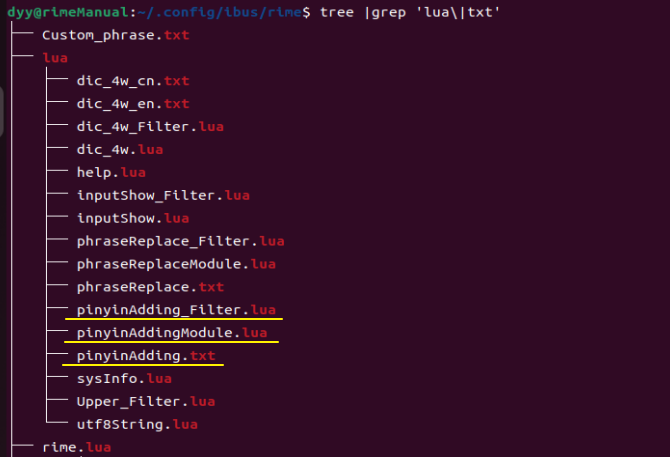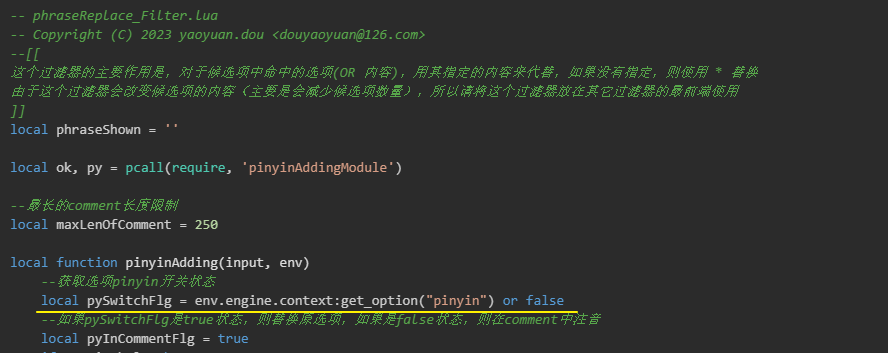rime中州韵小狼毫 生字注音滤镜 汉字注音滤镜
在中文环境下,多音字是比较常见的现象。对于一些不常见的生僻字,或者一些用于地名,人名中的常见字的冷门读音,如果不能正确的阅读,例如把 荥阳 读成了 miāo yáng,则会怡笑大方。
今天我们在rime中州韵小狼毫输入法中配置一个注音滤镜,以便我们在日常的文字输入时,可以经常的,实时的学习、复习、强化这些文字的读音,不做白字先生。
先睹为快
本文所分离的在rime中州韵小狼毫须鼠管输入法中的生字注音效果如下👇:

pinyinAdding.txt
首先,我们需要一个文档来记录和管理汉字与注音的信息。pinyinAdding.txt 文档的内容截取部分展示如下👇:
冔 冔(xǔ)
玏 玏(lè)
鹯 鹯(zhān)
亶 亶(dǎn)
荥 荥(yíng)
荥阳 荥(xíng)阳
👆以上,pinyinAdding.txt 文档中的内容主要有两列,以 tag 制表符分隔。第一列是汉字或者词组,第二列是带有注音的词组。顺序无先后。但在后续的lua滤镜中,会被处理成优先匹配词组的逻辑。例如词组荥阳会优先匹配荥(xíng)阳,而不是匹配成 荥(yíng)阳。
pinyinAddingModule.lua
我们有了字典文档 pinyinAdding.txt,但这并没有办法在输入引擎中直接使用。我们还需要一个lua脚本,将 pinyinAdding.txt 文档内的词组加载到lua程序中。pinyinAddingModule.lua 脚本文档中的脚本如下👇:
-- pinyinAddingModule.lua
-- Copyright (C) 2023 yaoyuan.dou <douyaoyuan@126.com>
local M={}
local dict={}
local dbgFlg = true
--引入系统变更处理模块
local ok, sysInfoRes = pcall(require, 'sysInfo')
local currentDir = sysInfoRes.currentDir
local userName = sysInfoRes.userName
--引入utf8String,用于处理utf8字符串
local of,utf8Str = pcall(require, 'utf8String')
local utf8Sub = utf8Str.utf8Sub
local utf8Len = utf8Str.utf8Len
--设置 dbg 开关
local function setDbg(flg)
dbgFlg = flg
sysInfoRes.setDbg(flg)
print('pinyinAddingModule dbgFlg is '..tostring(dbgFlg))
end
--将文档处理成行数组
local function files_to_lines(...)
if dbgFlg then
print("--->files_to_lines called here")
end
local tab=setmetatable({},{__index=table})
local index=1
for i,filename in next,{...} do
local fn = io.open(filename)
if fn then
for line in fn:lines() do
if not line or #line > 0 then
tab:insert(line)
end
end
fn:close()
end
end
if dbgFlg then
print("--->files_to_lines completed here")
end
return tab
end
local function dictload(...) -- filename)
if dbgFlg then
print("-->dictload called here")
end
local lines=files_to_lines(...)
local thisDict={}
for i,line in next ,lines do
if not line:match("^%s*#") then -- 第一字 # 为注释行
local key,val = string.match(line,"(.+)\t(.+)")
if nil ~= key then
--此处,如果key 已经存在,则使用后来的值顶替旧的值
if ''~=val then
thisDict[key] = val
end
end
end
end
if dbgFlg then
print("-->dictload completed here")
end
return thisDict
end
--===========================test========================
local function test(printPrefix)
if nil == printPrefix then
printPrefix = ' '
end
if dbgFlg then
print(printPrefix,'pinyinAddingModule test starting...')
sysInfoRes.test(printPrefix..' ')
for k,v in pairs(dict) do
if dbgFlg then
print(printPrefix..k..'\t'..v)
end
end
end
end
--这是一个递归函数,用于在给定的字符串中查找最大能匹配的子串
local function getItmInDicByStr(Str)
Str = Str or ''
if ''==Str then
--返回子串值,匹配值,匹配长度
return '','',0
end
local itmKey,itmLen,itmVal,strLen,flg
strLen = utf8Len(Str)
flg=false
for idx=strLen,1,-1 do
itmKey = utf8Sub(Str,1,idx)
if''~=itmKey then
itmVal = dict[itmKey]
if nil~=itmVal then
itmLen = idx
flg = true
break
end
end
end
if flg then
return itmKey,itmVal,itmLen
else
return '','',0
end
end
local function pinyinAdding(k)
k = k or ''
if ''==k then
return k
end
local valStr,kLen
local subK,subKVal,subKLen
local matchPosition
valStr = ''
kLen = utf8Len(k)
matchPosition = 1
while matchPosition <= kLen do
subK,subKVal,subKLen = getItmInDicByStr(utf8Sub(k,matchPosition,kLen))
if ''==subK then
valStr = valStr..utf8Sub(k,matchPosition,1)
matchPosition = matchPosition + 1
else
valStr =valStr..subKVal
matchPosition = matchPosition + subKLen
end
end
return valStr
end
function M.init(...)
local files={...}
--文件名不支持中文,其中 # 开始的行为注释行
table.insert(files,"pinyinAdding.txt")
for i,v in next, files do
files[i] = currentDir().."/".. v
end
dict= dictload(table.unpack(files))
--抛出功能函数
M.pinyinAdding = pinyinAdding
M.pinyinAddingT = pinyinAdding
M.setDbg = setDbg
M.test = test
end
M.init()
return M
👆以上脚本中,我们将指定的 pinyinAdding.txt 文档中的词组加载为一个 dict 的字典对象,然后给出了一个检索字典的方法 pinyinAdding。我们通过方法pinyinAdding可以方便的检索出指定关键字的注音版本词组。
pinyinAdding_Filter.lua
在脚本文档 pinyinAddingModule.lua 中,我们加载并定义了词组的检索方法。现在我们需要在脚本文档 pinyinAdding_Filter.lua 内将词组检索方法整理成rime引擎的滤镜方法,pinyinAdding_Filter.lua文档内的脚本如下👇:
-- phraseReplace_Filter.lua
-- Copyright (C) 2023 yaoyuan.dou <douyaoyuan@126.com>
--[[
这个过滤器的主要作用是,对于候选项中命中的选项(OR 内容),用其指定的内容来代替,如果没有指定,则使用 * 替换
由于这个过滤器会改变候选项的内容(主要是会减少候选项数量),所以请将这个过滤器放在其它过滤器的最前端使用
]]
local phraseShown = ''
local ok, py = pcall(require, 'pinyinAddingModule')
--最长的comment长度限制
local maxLenOfComment = 250
local function pinyinAdding(input, env)
--获取选项pinyin开关状态
local pySwitchFlg = env.engine.context:get_option("pinyin") or false
--如果pySwitchFlg是true状态,则替换原选项,如果是false状态,则在comment中注音
local pyInCommentFlg = true
if pySwitchFlg then
pyInCommentFlg = false
end
for cand in input:iter() do
local txtWithPy = py.pinyinAdding(cand.text)
if nil == txtWithPy then
--没有获取到 txtWithPy,则不做处理
yield(cand)
elseif txtWithPy == cand.text then
--txtWithPy 与 原候选词一致,则不做处理
yield(cand)
else
--获取到了 txtWithPy,且不与原候选词一致
if pyInCommentFlg or string.find(cand.comment,'?') then
--如果需要加到comment里,或者这是一个自造词,为了不影响自造词功能,也需要加到commnet里
if ''==cand.comment then
cand:get_genuine().comment = txtWithPy
else
if utf8.len(cand.comment) < 5 then
cand:get_genuine().comment = cand.comment..'?'..txtWithPy
else
cand:get_genuine().comment = cand.comment..'\r?'..txtWithPy
end
end
yield(cand)
else
--如果不加到comment,则替换原选项,注意,替换原选项,会影响自动调频功能
cand.text = txtWithPy
if cand.text == txtWithPy then
yield(cand)
else
yield(Candidate("word", cand.start, cand._end, txtWithPy, cand.comment))
end
end
end
end
end
return pinyinAdding
👆以上脚本中, 我们定义了滤镜方法 pinyinAdding 并返回/抛出了该方法。
💣注意:
以上所述文档 pinyinAdding.txt,pinyinAddingModule.lua,pinyinAdding_Filter.lua 三个文档,应该位于 用户文件夹 下的 lua 文件夹内。如下👇:

rime.lua
以上我们完成了 pinyinAdding 滤镜方法的定义,现在我们需要在文档 rime.lua 中将该 pinyinAdding 滤镜方法映射成 pinyinAdding_Filter 滤镜接口。我们在 rime.lua 中增加以下👇脚本:
help_translator = require("help")
inputShow_translator = require("inputShow")
inputShow_Filter = require("inputShow_Filter")
Upper_Filter = require("Upper_Filter")
dic_4w_Filter = require("dic_4w_Filter")
phraseReplace_Filter = require("phraseReplace_Filter")
pinyinAdding_Filter = require("pinyinAdding_Filter")
👆以上脚本中,注音最后一行的 pinyinAdding_Filter 的定义。
wubi_pinyin.custom.yaml
以上步骤中,我们完成了pinyinAdding_Filter滤镜的定义。现在万事俱备,只欠东风了。我们只需要在我们的输入方案中配置引用该 pinyinAdding_Filter 滤镜,即可看到文字注音的效果了。
现在我们以 五笔?拼音 输入方案为例来配置生字注音滤镜。我们在 五笔?拼音输入方案的方案文档 wubi_pinyin.schema.yaml 的补丁文档 wubi_pinyin.custom.yaml 加入以下👇配置:
patch:
switches/+: #增加以下开关
- name: pinyin # 这个开关用于标记是否打开拼音滤镜
reset: 0
states: [Off, pīnyīn]
engine/filters: # 设置以下filter
- simplifier
# 下面的滤镜是comment滤镜,不会改变候选项列表
- lua_filter@pinyinAdding_Filter # pinyin滤镜,用于对候选项中的字添加拼音
👆以上的配置中,我们增加了两项内容,一个是switch开关pinyin, 一个是lua_filter 滤镜 pinyinAdding_Filter。这是因为我们在 pinyinAdding_Filter.lua 脚本中会检测开关pinyin的状态以决定是否启用滤镜功能。如下👇:

💣注意:
文档 rime.lua 和 wubi_pinyin.custom.yaml 都应该位于 用户文件夹下,这不需要再多说什么了。
pinyinAdding.txt/pinyinAddingModule.lua/pinyinAdding_Filter.lua/rime.lua/wubi_pinyin.custom.yaml 文档
👆以上所述 pinyinAdding.txt、pinyinAddingModule.lua、pinyinAdding_Filter.lua、rime.lua、wubi_pinyin.custom.yaml 五个文档,你也可以在 rime中州韵小狼毫 生字注音滤镜.zip 下载取用。
效果欣赏
做完了以上的配置工作,不要忘了 重新部署 你的 rime。然后你就应该能够观察到文字注音效果了。如下👇:

小结
本文分享了一种在rime中州韵小狼毫须鼠管输入法中配置生字注音滤镜的方法,并以五笔?拼音 输入方案为例,配置并演示了生字注音滤镜的功能效果。本文所配置文档共5个,其中 pinyinAdding.txt 文档为词组管理文档,通过这个文档可以非常方便的增删管理生字及其注音信息;pinyinAddingModule.lua 脚本文档提供了 pinyinAdding.txt 词组的加载和解析功能,并提提供了检索方法的接口;pinyinAdding_Filter.lua 文档定义了基于rime引擎接口的滤镜方法;最后我们在 rime.lua 脚本和 wubi_pinyin.custom.yaml 文档中配置和使用了该滤镜。并在最终的功能效果中观察到了预期的功能效果。
本文来自互联网用户投稿,该文观点仅代表作者本人,不代表本站立场。本站仅提供信息存储空间服务,不拥有所有权,不承担相关法律责任。 如若内容造成侵权/违法违规/事实不符,请联系我的编程经验分享网邮箱:veading@qq.com进行投诉反馈,一经查实,立即删除!